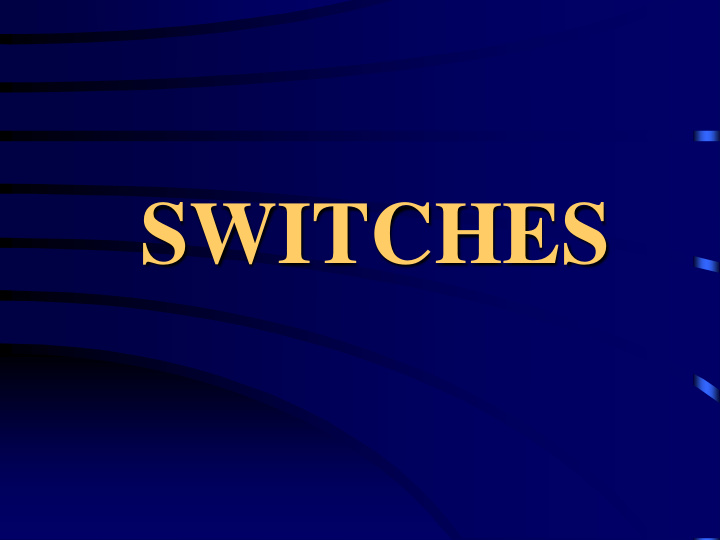



SWITCHES
Basic Elements of a Circuit • Three Essential Elements – Load – Complete Path – Power Source • Additional Elements – Control Device – Protective Device
A switch is a component that allows us to control whether the current is on or off in a circuit. A closed switch has practically zero resistance. An open switch has nearly infinite resistance.
Basic Switch Function • To open and close a circuit – Open (no connection) – Closed (connection) • Control device – Does not consume power
Schematic Terms Pole- • It is defined as the number of completely isolated circuits that can be controlled by the switch. • It refers to the number of input circuits of the switch Throw- • It is defined as the number of closed contact positions that exist per pole. • It refers to the number of output circuits of the switch Pole Throw
Types of Switches • Single-pole, single throw(SPST) • Single-pole, double throw(SPDT) • Double-pole, single-throw (DPST) • Double-pole, double-throw(DPDT)
Single Pole, Single Throw • It can control the current in only one circuit, and there is only one closed contact position, hence the name single-pole, single-throw • 1 pole, 1 throw • Example- room lights
SPST Animation
Single Pole, Double Throw • SPDT • 1 pole • 2 throws, 2 closed positions
SPDT Animation
Double Pole, Single Throw • DPST • It is used to control two completely separate circuits simultaneously. • 2 poles, 1 throw • Not 2 throws because of mechanical connection. • Both armatures make contact at same time- one closed position
DPST
DPST Animation
Double Pole, Double Throw • DPDT • A DPDT switch is used to reverse the polarity of voltage across the terminals of a dc motor. (Reversing the polarity reverses the direction of the motor.) • 2 poles • 2 separate closed positions
DPDT Animation
Switch Styles Slide Toggle
Switch Styles Push On/Off Rocker
Other Switches • Momentary contact switches – Push button switches • Rotary switches
Momentary Contact • Push Button Normally Open • PBNO • Red in color
PBNO
Momentary Contact • Push Button Normally Closed • PBNC • Black in color
PBNC
Rotary Switches • Used for complex circuits • Can have multiple throws
Rotary Switch • Example- Stereo input selector
#1) ?P?T
#2) ?P?T
#3) ?P?T
#4) ?P?T
#1) 3P1T
#2) 2P5T
#3) 3P2T
#4) 3P3T
Review • What are the three basic parts of a circuit? • What else can a circuit include? • What is the main function of a switch? • What is the difference between a throw and a pole? • What other types of switches are available?
FUSES
Fuses • A fuse protects the circuit components against excessive current. • Excessive current melts the fuse element, blows the fuse, and opens the series circuit before damage can occur to the components or wiring. • Slow-blow fuses are designed to open only on a continued overload, such as a short circuit, rather than a temporary current surge.
Testing Fuses • When measured with an ohmmeter, a good fuse has practically zero resistance. An open fuse reads infinite ohms. • When measured with a voltmeter, a good fuse has zero volts across its two terminals. If there is significant voltage across the fuse, it is open.
SAMPLE FUSES Glass-cartridge fuse Fuse holder Panel-mounted fuse holder Circuit Board Fuses
CIRCUIT BREAKERS • A circuit breaker can be used in place of a fuse to protect circuit components and wiring against the high current caused by a short circuit. • It is constructed of a thin bimetallic strip that expands with heat and in turn trips open the circuit. • The advantage of a circuit breaker is that it can be reset once the bimetallic strip cools down and the short circuit has been removed. • Almost all new residential house wiring is protected by circuit breakers rather than fuses.
Recommend
More recommend